Understanding AI in Data Analytics: Importance and Applications

Understanding AI in Data Analytics: Importance and Applications
Overview
The article emphasizes the significance and applications of AI in data analytics, particularly its role in automating data processing and enhancing decision-making across various sectors. One of the key features of AI is its ability to analyze vast amounts of data quickly and accurately. This capability provides a distinct advantage: it allows organizations to make informed decisions based on real-time insights. The benefits of this integration are evident in companies like PepsiCo and UPS, which have successfully harnessed AI to improve operational efficiency and minimize manual tasks.
By showcasing these examples, the article illustrates the transformative potential of AI-driven insights in business strategies. How can your organization leverage similar technologies to enhance its operations? As AI continues to evolve, its applications in data analytics will likely expand, offering even more opportunities for businesses to optimize their processes. In conclusion, embracing AI not only streamlines operations but also positions companies to adapt to the rapidly changing market landscape.
Introduction
The integration of artificial intelligence into data analytics is fundamentally reshaping how organizations interpret vast amounts of information. This transformation drives efficiency and precision in decision-making. As companies increasingly adopt AI-powered tools, they unlock the potential for deeper insights and enhanced operational strategies that were once unimaginable. However, amidst the promise of these transformative capabilities lies a pressing question: how can businesses effectively navigate the challenges of implementing AI while ensuring ethical practices and data integrity?
This exploration delves into the significance, applications, and future trends of AI in data analytics. It offers a roadmap for organizations eager to harness its full potential, highlighting the features of AI technologies, the advantages they bring to data interpretation, and the benefits that can be realized in operational effectiveness. By understanding these elements, businesses can better position themselves to leverage AI responsibly and effectively.
Defining AI in Data Analytics: Key Concepts and Significance
The application of sophisticated algorithms and machine learning techniques in AI in data analytics allows for the examination and interpretation of complex datasets. This integration offers significant advantages, automating data processing and resulting in faster and more accurate insights. For instance, companies like SavvyIQ leverage AI-powered APIs to enhance traditional analytics by identifying patterns, predicting outcomes, and delivering actionable recommendations. These capabilities are crucial for informed decision-making across sectors such as market research, finance, and healthcare.
The benefits of SavvyIQ's proprietary Recursive Data Engine are evident as it continuously enriches a dynamic graph of 265 million global entities. This fundamentally transforms how organizations utilize information for strategic advantage. The significance of AI in data analytics is underscored by its ability to efficiently manage large volumes of information, allowing enterprises to automate processes and eliminate manual information tasks throughout their operations.
Consider the example of PepsiCo, which has leveraged AI to achieve near real-time visibility in their operations, drastically reducing manual extract-transfer-load (ETL) efforts. Similarly, UPS utilizes AI-driven route optimization models that examine over 200 information points per route. This not only conserves millions of gallons of fuel each year but also enhances delivery efficiency. These practical applications demonstrate how the use of AI in data analytics boosts processing speed and enhances precision, allowing companies to react proactively to market shifts and operational hurdles.
Moreover, AI's capability to automate repetitive tasks, such as cleaning and validation, enables teams to focus on uncovering insights rather than resolving issues. As organizations increasingly embrace AI-powered insights, they can anticipate a notable increase in productivity and decision-making abilities, ultimately leading to improved business results. How might your organization leverage AI to enhance its operations and decision-making processes?
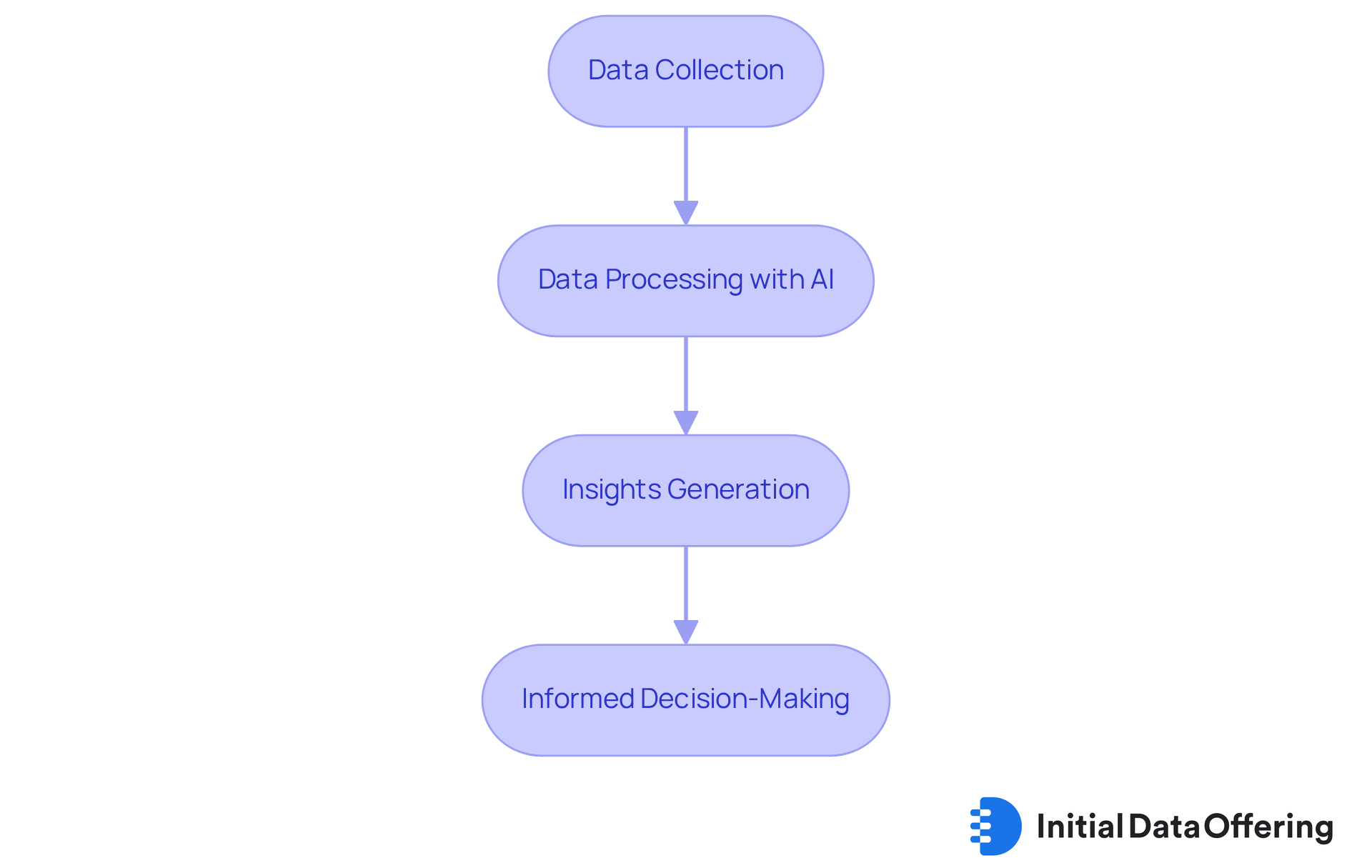
Historical Context: The Evolution of AI in Data Analytics
The evolution of AI in data analytics can be traced back to the mid-20th century, marked by early advancements in computer science and algorithm design. Initially, efforts concentrated on rule-based systems and basic statistical methods, which laid the groundwork for future developments. However, the emergence of machine learning in the 1980s was a significant turning point, allowing systems to learn from information rather than relying solely on predefined rules. As Naveen Edapurath Vijayan, Sr Manager of Data Engineering at AWS, observes, "AI is not just a future possibility—it is a vital requirement for organizations seeking competitive advantage in today's data-centric world."
The introduction of deep learning in the 2010s further revolutionized the field, enabling the analysis of unstructured information such as images and text. The use of AI in data analytics now empowers companies to process millions of information points in seconds, greatly accelerating the production of insights. This transition from conventional dashboards to cooperative, reliable agents in information analysis enhances the capabilities of analysts and researchers. Consequently, organizations can make informed choices based on actionable insights derived from extensive datasets through the use of AI in data analytics.
Furthermore, as organizations increasingly adopt AI-driven insights, it is essential to establish frameworks for the ethical and fair use of these technologies. How can we ensure that the deployment of AI does not perpetuate inequalities or cause unintended harm? Addressing these concerns is crucial as we navigate the complexities of AI integration in our data-driven world.
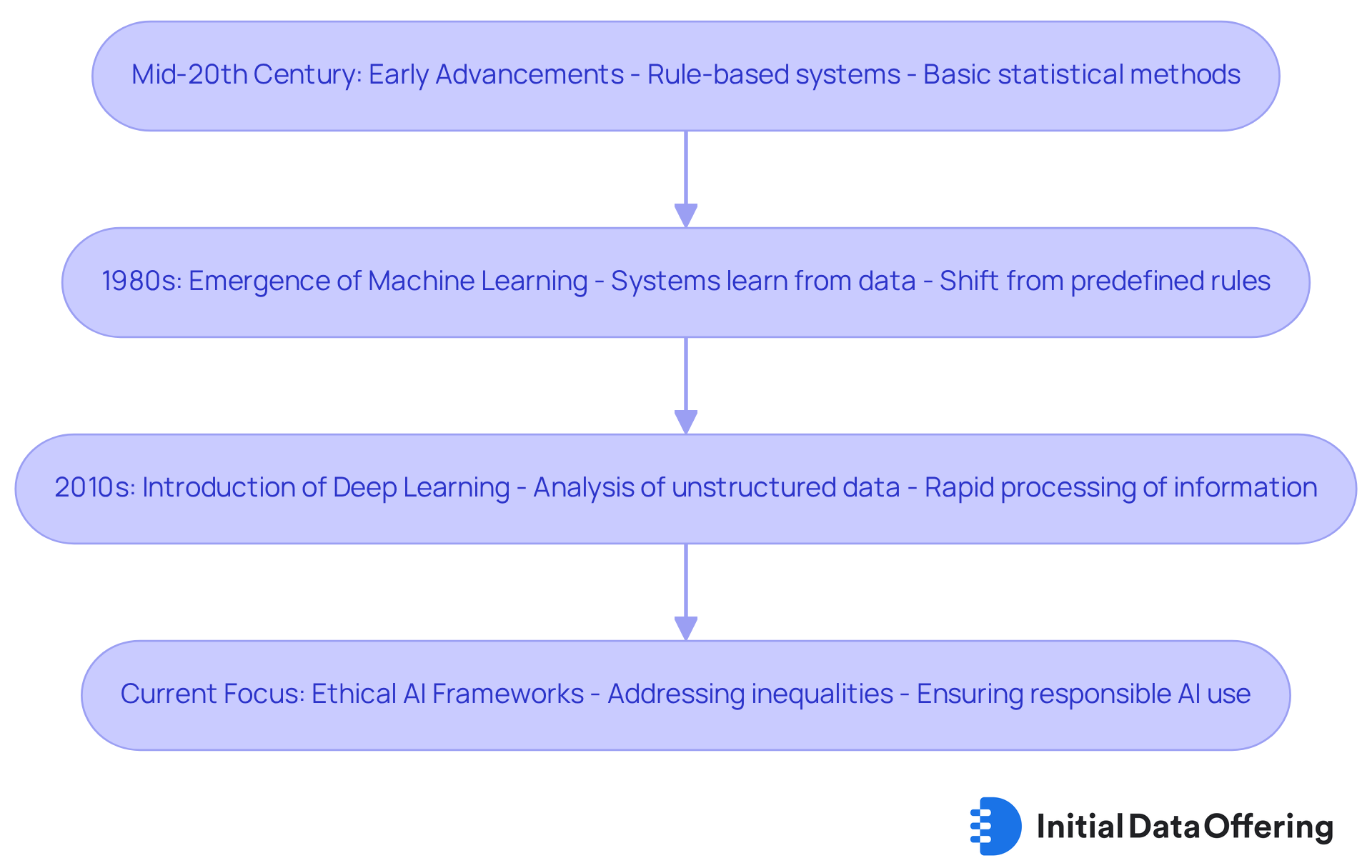
Applications and Benefits of AI in Data Analytics for Market Research
AI applications in market research are diverse and transformative.
- Features of AI-driven analytical tools include automation of data gathering and cleansing, which significantly reduces the time and effort needed for these tasks.
- Advantages of these tools lie in their ability to analyze consumer sentiment from social media, providing businesses with real-time insights into public perception. With a potential audience for social media sentiment engagement reaching 4.76 billion users, the importance of understanding consumer opinions is paramount.
- Benefits extend further with predictive analytics powered by AI, enabling companies to forecast market trends and consumer behavior, thus allowing for proactive strategy adjustments.
The benefits of these applications are substantial:
- Enhanced accuracy in data interpretation
- Increased efficiency in research processes
- The ability to uncover insights that traditional analysis methods might overlook
As companies increasingly recognize the significance of sentiment analysis, they can tailor marketing strategies and improve customer service, ultimately fostering brand loyalty and promoting growth. For instance, a South African bank's analysis of 2 million social media posts led to improved service delivery and reduced customer attrition, illustrating the practical impact of sentiment analysis in real-world scenarios.
Furthermore, 73% of clients express a desire for companies to acknowledge their specific needs, underscoring the critical importance of understanding customer feelings. Tailored experiences can enhance brand loyalty by 1.5 times, further emphasizing the positive influence of AI on customer relationships. As Nitesh Kasma observes, sentiment analysis serves as a digital 'mood detector' for customer opinions, assisting businesses in making informed decisions.
How can your organization leverage these insights to enhance customer engagement? Consider the transformative potential of AI in data analytics to reshape your market research strategies.
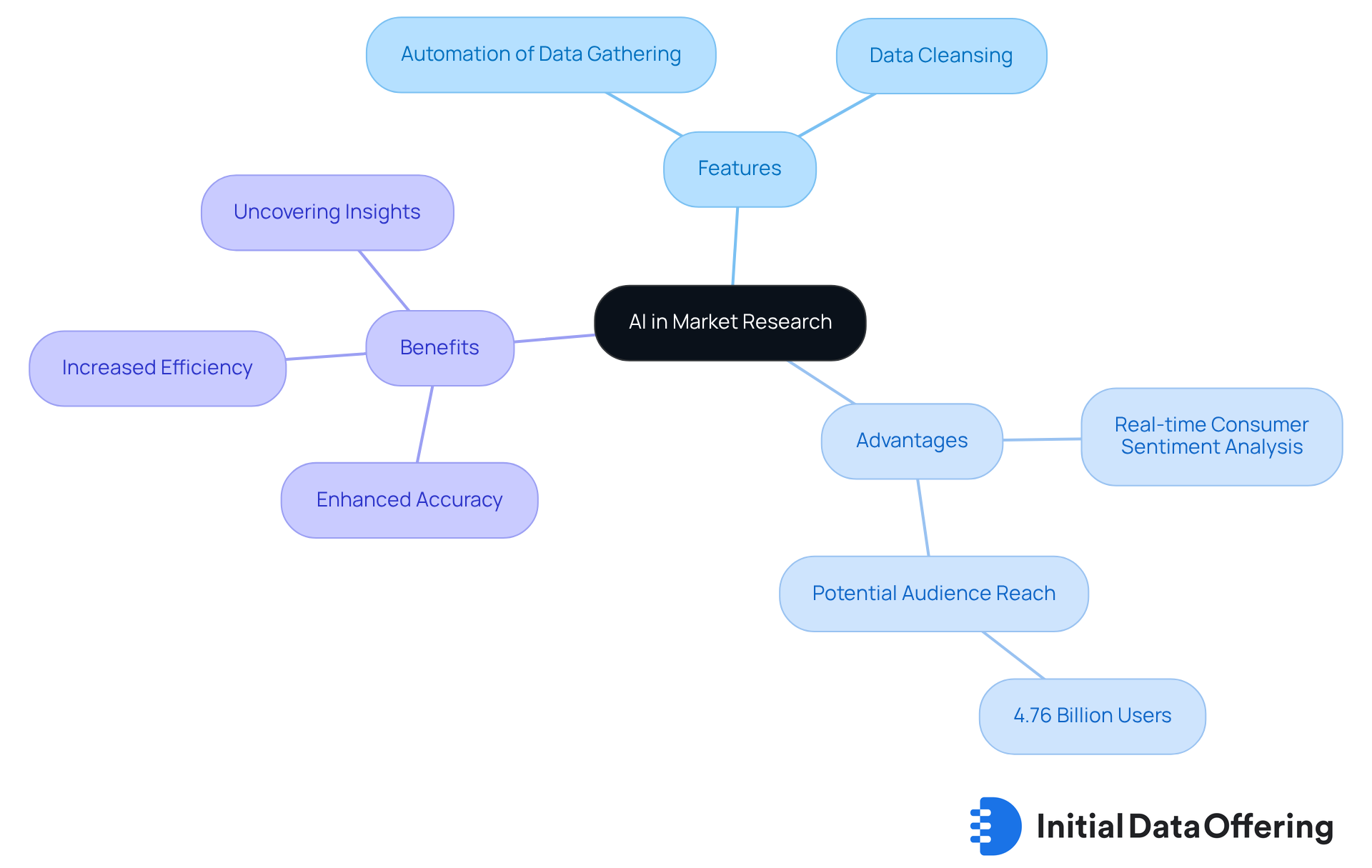
Challenges and Considerations in Implementing AI in Data Analytics
Utilizing AI in data analytics presents significant challenges, particularly concerning the quality of information. High-quality, well-organized data is essential for AI systems to operate effectively; however, a staggering $3 trillion is lost annually due to inadequate information quality. This issue is compounded by resistance from staff accustomed to traditional analytics methods and ethical concerns surrounding privacy and algorithmic bias. Furthermore, integrating AI with existing systems can be complex and costly, leading many organizations to find themselves in 'pilot purgatory,' where they struggle to transition successful AI experiments into full-scale production. As Deborah Perry Piscione notes, many firms remain trapped in this state due to their inability to scale promising experiments effectively.
To address these challenges, organizations must prioritize robust information governance frameworks that ensure both accuracy and integrity. This involves establishing stringent information management protocols and fostering a culture of innovation that embraces evidence-based decision-making. Training programs play a critical role in this process, equipping employees with the skills necessary to leverage AI tools effectively. Notably, only 44% of information and analysis teams are considered efficient in delivering value to their organizations, underscoring the need for comprehensive training and skill development. Additionally, businesses should integrate ethical considerations into their AI development processes to mitigate ethical risks and ensure compliance with AI-related regulations. By investing in these areas, organizations can overcome quality challenges and unlock the full potential of AI in data analytics, ultimately enhancing their competitive advantage in the marketplace.
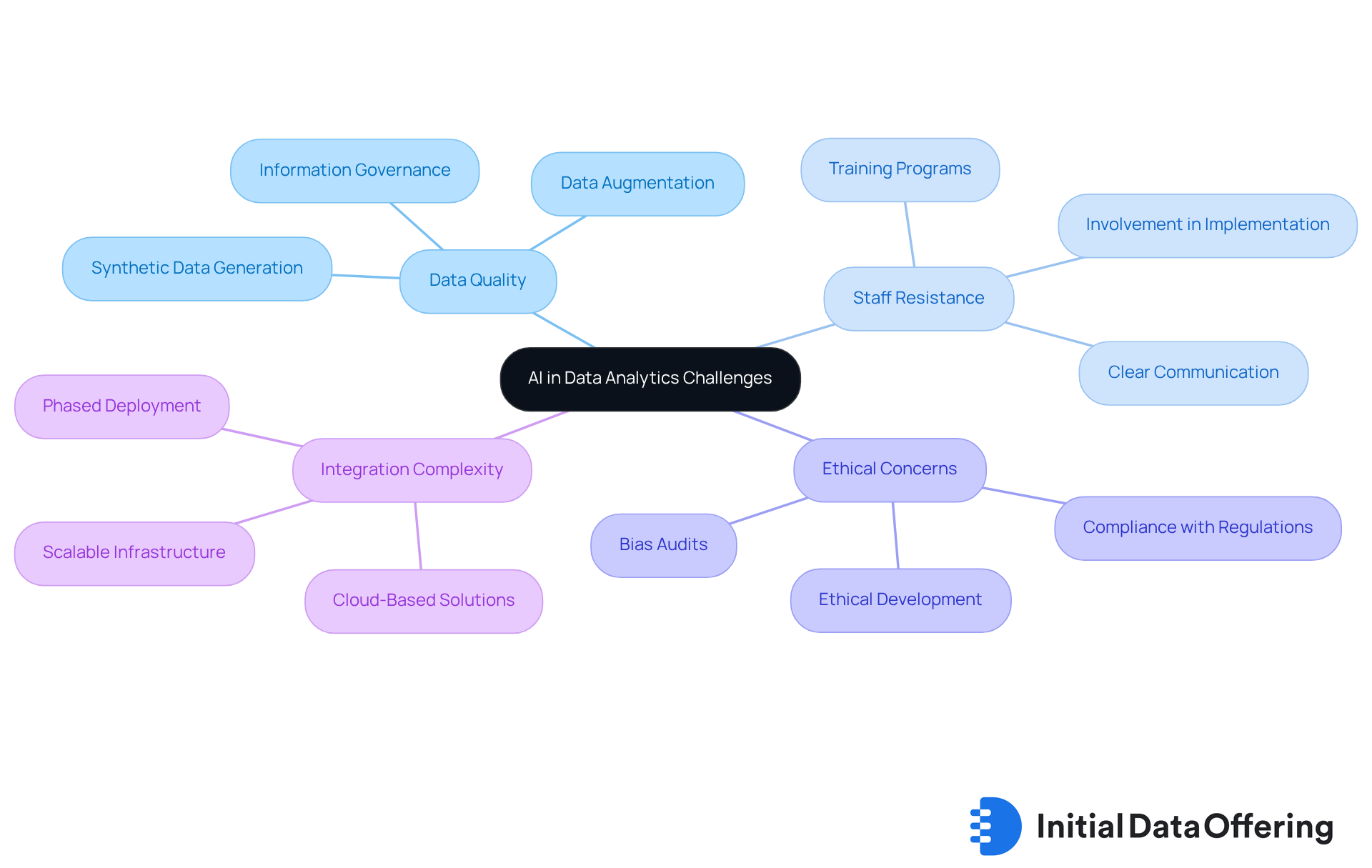
Future Trends in AI and Data Analytics
Looking forward, several trends are set to influence the future of AI in data analytics. The rise of generative AI is anticipated to improve information synthesis and scenario modeling, enabling more nuanced insights. For instance, a significant 58% of information and AI leaders report experiencing exponential productivity or efficiency improvements from AI, underscoring its transformative potential.
Moreover, the integration of AI in data analytics with Internet of Things (IoT) devices will facilitate the analysis of real-time information. This development offers businesses prompt feedback on operational performance, which is crucial for timely decision-making. As ethical AI practices gain prominence, companies will strive to ensure transparency and fairness in their analytics processes.
As Sarah Bird, Microsoft’s chief product officer of Responsible AI, emphasizes, rigorous testing and measurement in AI is essential for maintaining safety and relevance. Organizations that embrace these trends will be better positioned to leverage AI in data analytics for strategic advantage and drive innovation. Furthermore, advancements in AI models expected by 2025 will enhance the capabilities of generative AI, making it an integral part of data-driven decision-making.
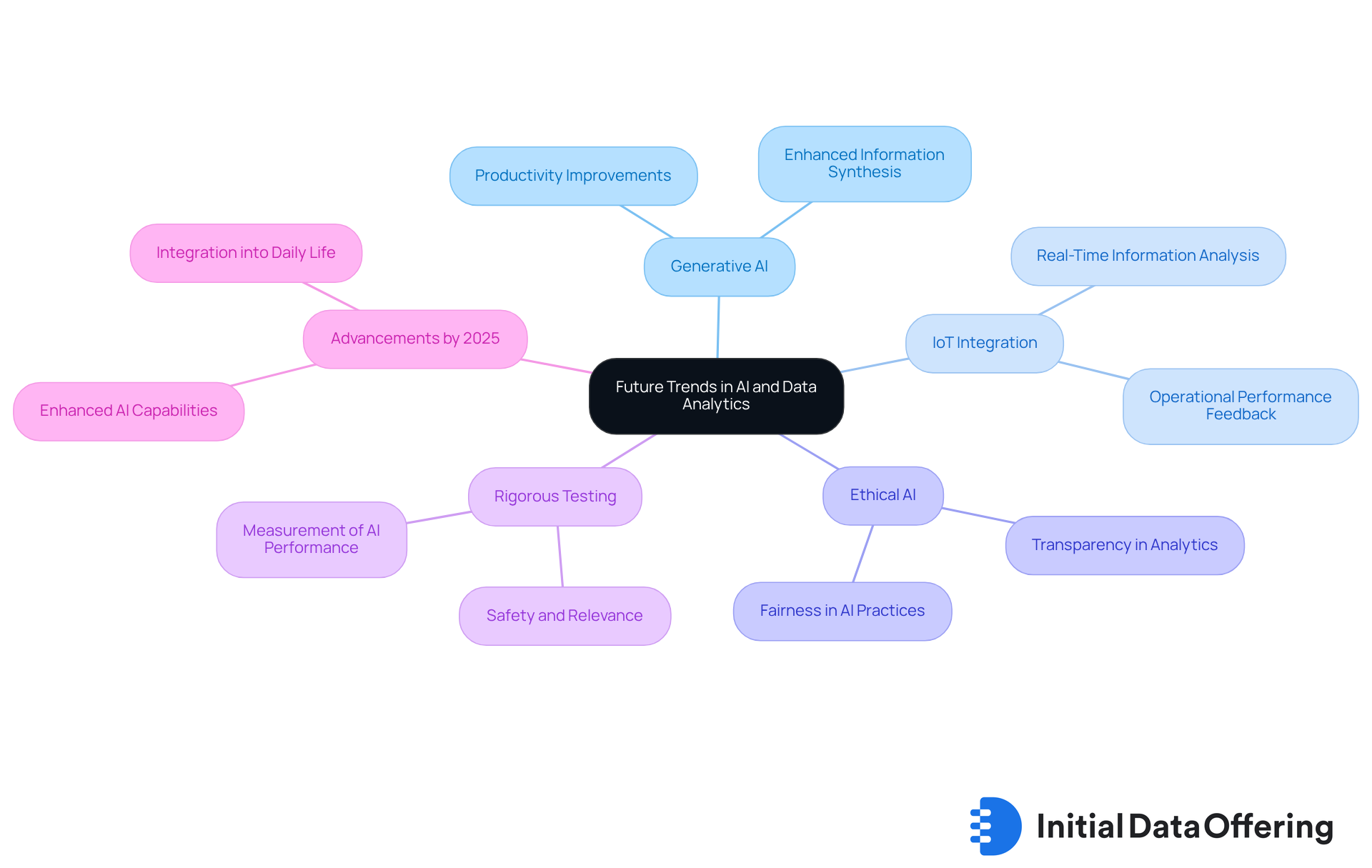
Conclusion
The integration of artificial intelligence in data analytics signifies a pivotal shift in how organizations process and leverage information. By automating complex data tasks and enhancing analytical capabilities, AI empowers businesses to make informed decisions swiftly and accurately. This transformation is not merely a trend; it is essential for maintaining a competitive edge in an increasingly data-driven landscape.
Throughout the article, several key insights highlight the significance of AI across various sectors. For instance, companies like PepsiCo and UPS exemplify the practical benefits of AI applications, from automating data processing to improving operational efficiency. Furthermore, the evolution of AI from basic algorithms to sophisticated machine learning techniques has revolutionized data analytics, enabling the analysis of vast datasets in real time and fostering a deeper understanding of consumer behavior through sentiment analysis. However, organizations must navigate challenges such as data quality and ethical considerations to fully harness the potential of AI.
As the landscape of data analytics continues to evolve, embracing AI offers a pathway to innovation and strategic advantage. Organizations are encouraged to explore how AI can enhance their operations, streamline processes, and ultimately improve decision-making. By investing in robust data governance and ethical AI practices, businesses can not only overcome existing challenges but also position themselves for future success in a rapidly changing environment. Embracing these advancements is not just beneficial; it is imperative for organizations aiming to thrive in the digital age.
Frequently Asked Questions
What is the significance of AI in data analytics?
AI in data analytics is significant because it automates data processing, leading to faster and more accurate insights. It allows organizations to efficiently manage large volumes of information, automate processes, and eliminate manual tasks, which enhances decision-making across various sectors.
How does AI enhance traditional analytics?
AI enhances traditional analytics by identifying patterns, predicting outcomes, and delivering actionable recommendations. For example, companies like SavvyIQ use AI-powered APIs to improve their analytics capabilities.
What are some practical applications of AI in data analytics?
Practical applications include PepsiCo achieving near real-time visibility in operations, reducing manual ETL efforts, and UPS utilizing AI-driven route optimization models to enhance delivery efficiency and save fuel.
What historical advancements have influenced AI in data analytics?
The evolution of AI in data analytics began in the mid-20th century with early computer science advancements. The introduction of machine learning in the 1980s and deep learning in the 2010s were significant turning points, allowing systems to learn from data and analyze unstructured information.
How does AI impact productivity and decision-making in organizations?
AI automates repetitive tasks like data cleaning and validation, enabling teams to focus on uncovering insights. This leads to increased productivity and improved decision-making capabilities, ultimately enhancing business results.
What ethical considerations are associated with the use of AI in data analytics?
As organizations adopt AI-driven insights, it is essential to establish frameworks for the ethical and fair use of these technologies to prevent perpetuating inequalities or causing unintended harm. Addressing these concerns is crucial for responsible AI integration.